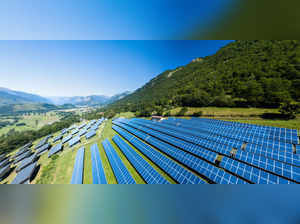
Powered By
Moving to clean energy could also bring savings of up to $4.6 trillion each year, according to new research from Colorado-based think tank RMI.
People don’t want coal, oil or gas. Rather they want the products and services that the energy provides — home heating, public transport or sheets of steel.
The distinction is important as we move away from fossil fuels and toward clean energy , because it will mean the world could be consuming less energy in total without losing out the benefits it currently enjoys.
Poll Trackers Leaders flock to Delhi after BJP fails to get absolute majority| Catch it all live Lost majority, but BJP has breached these citadels for the future Weaker Modi 3.0 to slow India's big fiscal fight: Moody’s We waste about a third of the total energy produced on mining, refining and transporting fossil fuels.
Crude oil on its own isn’t much use until it is converted to gasoline , jet fuel and fuel oil. But creating those products requires huge refineries consuming vast amounts of energy.
Crucially, all that dirty energy has a huge planet-warming impact.
Producing solar panels and wind turbines has a much smaller carbon footprint.
Moving to clean energy could also bring savings of up to $4.6 trillion each year, according to new research from Colorado-based think tank RMI . Another third of the world’s total energy is wasted in burning fossil fuels in highly inefficient machines.
For example, a fossil fuel-powered car converts only a quarter of the energy in gasoline into motion.
An electric car converts more than three-quarters of the energy in the battery to moving.
Similarly, while burning one unit of natural gas in a boiler generates one unit of heat, an electric heat pump uses one unit of electricity to provide three units of heat.
Experts refer to the sum total of energy content found in nature, such as blocks of coal, as primary energy.
After accounting for losses from production and transportation, what remains is final energy.
Bloomberg “There’s so much room to become more efficient,” said Daan Walter of RMI . “Most of the discussion on energy security is to secure supplies of energy, but there is very little acknowledgement that reducing demand for energy also helps with energy security.
” It’s why the white paper that Walter co-authored with his RMI colleagues is titled: The Incredible Inefficiency of the Fossil Energy System.
Without alternatives to fossil fuels, that incredible inefficiency was just the cost of doing business.
But as the world moves to generating more power from renewables and converts more of its energy-consuming devices to electricity, the overall efficiency of the system goes up. At the COP28 climate summit in Dubai last year, countries signed off on two major goals among a long list: tripling renewable energy and doubling energy efficiency . The International Energy Agency today put out its report card on the renewables goal.
Its conclusion is that, if countries achieved their stated plans, the world will have 2.2 times as much renewables in 2030 over 2022 levels.
That’s short of its tripling goal and thus a lot more needs to be done.
The efficiency goal hasn’t yet received a report card.
Still, there is much we can glean based on the data we already have.
The goal is defined in terms of improving the energy intensity of the economy, which is how much energy it takes to generate a dollar of economic activity.
Over the past few decades, the energy intensity of the economy — or energy efficiency — has been increasing at between 1% and 2% each year, while global economic growth hovers at 3%. That means, even as the global economy is becoming more energy efficient, it’s not enough to reduce the total amount of energy the world uses.
Doubling of energy efficiency up to 4% annually could help the world use less energy, even while keeping economic growth at the same levels.
Bloomberg The renewables goal is hard, but the push to achieve it is likely to be stronger than the one behind the energy efficiency goal.
“Very few people have a sense of what it means, or if it’s possible,” said Walter.
That’s because energy efficiency doesn’t make for great banter, he added.
It might be because the steps to get there, such as better insulation or software for energy management, aren’t “sexy” solutions.
But that can’t be the full story.
Electric cars and heat pumps are energy efficient machines.
One of those entered the public consciousness with a “cool” factor.
The efficiency gains of these machines perhaps didn’t matter in summing up the cool bits.
That has been a failure of our imagination — for now. Poll Trackers How will Modi-led NDA govt & BJP govt be different? India's new govt likely to vote for populism in budget
